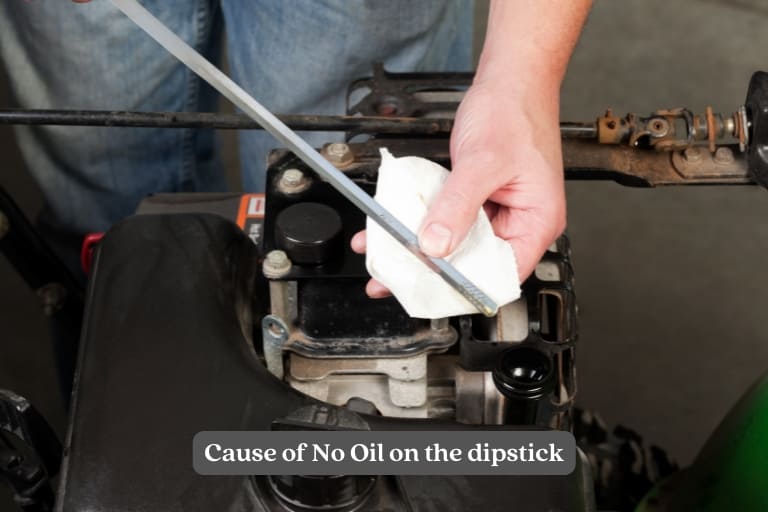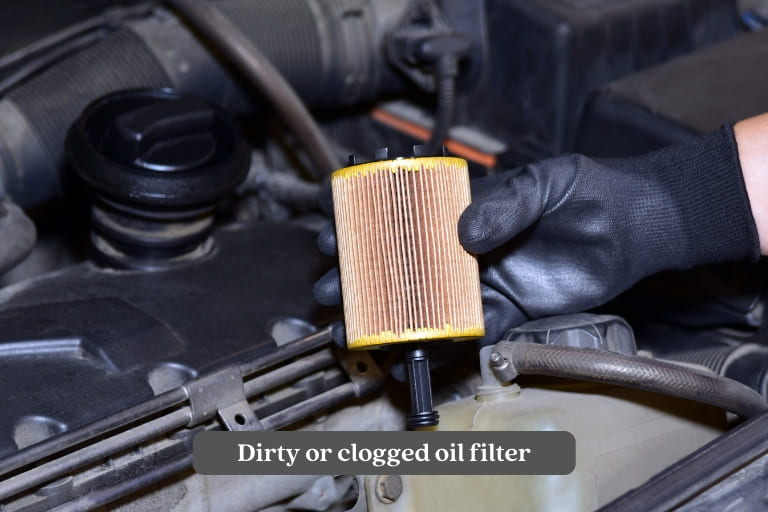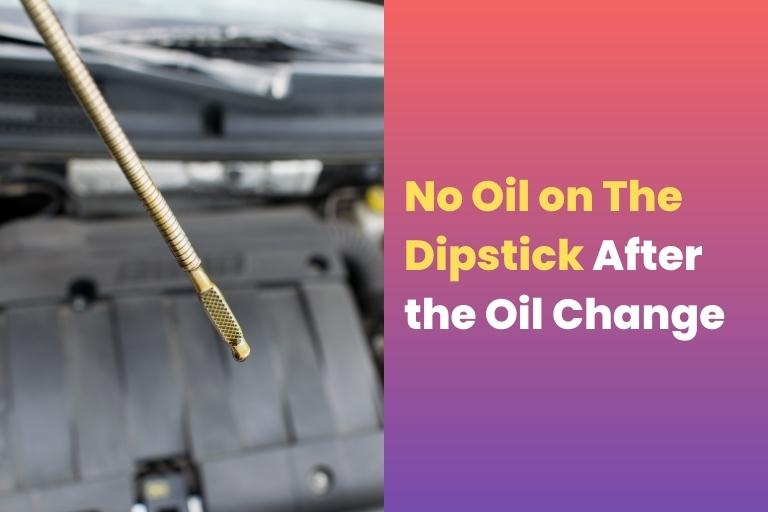When it comes to the maintenance of your vehicle, one of the most important tasks you can perform is checking the oil level regularly. The oil serves as the lifeblood of your engine, lubricating its various components and keeping it running smoothly. Your engine can suffer serious damage without adequate oil, leading to costly repairs or engine failure.
The dipstick is one method for checking your oil level. The dipstick is a long, thin piece of metal or plastic inserted into the engine’s oil reservoir. It provides a quick and easy way to measure the oil level in your engine and determine if it needs to be topped up.
In this article, we will discuss the importance of checking your oil level regularly and the potential consequences of neglecting this vital task. We will also explore some common reasons why your dipstick may show no oil after an oil change and what steps you can take to fix this issue.
By the end of this article, you will better understand why it is so important to keep an eye on your engine’s oil level and how to ensure that it is always at the right level for optimal engine performance.
Contents
- 1 What’s a Dipstick?
- 2 What does the Cause of No Oil on the dipstick?
- 3 Common Mistakes That Can Lead to No Oil on Dipstick After Oil Change
- 4 Common Reasons Why Oil Levels May Not Show Up on the Dipstick
- 5 How Do We Know If Dipstick Is Low On Oil?
- 6 What Happens If There Is No Oil On Dipstick?
- 7 What Do You Do If there is No Oil On Dipstick?
- 8 Frequently Asked Questions
- 9 Conclusion
What’s a Dipstick?
A dipstick is a tool for measuring the amount of oil in an engine’s oil reservoir. It is usually a long, thin piece of metal or plastic with minimum and maximum levels indicating the oil required for the engine to work effectively. Its purpose is to check the amount of oil.
The dipstick is placed into the engine’s oil reservoir to check the oil level and then withdrawn. A car owner or mechanic may easily evaluate if the engine requires additional oil or has enough oil to function safely and effectively by checking the quantity of oil on the dipstick.
What does the Cause of No Oil on the dipstick?

There might be various causes for the lack of oil on the dipstick. Inadequate oil added during an oil change, an oil leak or loss, a defective oil pump or pressure gauge, or an erroneous dipstick reading or measurement are all possible reasons. All of these factors are outlined below:
Insufficient oil is added during an oil change
If the appropriate amount of oil is not added during an oil change, the engine oil level may be too low, resulting in no oil on the dipstick. Use the right amount of oil during an oil change to avoid engine harm.
Oil leak or loss
A leak or loss of oil could be the cause of no oil on the dipstick. If there is an oil leak or loss, the oil level in the engine might decrease to the point where the dipstick shows no oil. To avoid engine damage, check for and repair any oil leaks regularly.
Faulty oil pump or oil pressure gauge
A defective oil pump or pressure gauge might also cause no oil on the dipstick. The oil pump circulates oil throughout the engine; the oil level may drop if it fails. Similarly, the oil level may only be appropriately shown if the oil pressure gauge operates properly. It is critical to have these components examined and serviced as needed to avoid engine damage.
Incorrect dipstick reading or measurement
The dipstick can give an inaccurate reading if it is not inserted properly or if the engine has been running and the oil has not had time to settle. In some cases, the dipstick itself may need to be fixed or repaired, leading to incorrect measurements.
Common Mistakes That Can Lead to No Oil on Dipstick After Oil Change
Numerous typical errors might result in no oil on the dipstick during an oil change:
- Adding too much or too little oil
Applying too much or too little oil during an oil change might result in no oil on the dipstick. Too much oil can produce foaming and prevent the oil from settling, while too little oil might result in an inadequate oil level.
- Not providing enough time for the oil to settle
After adding oil, it is vital to let the engine sit for a few minutes to enable it to settle before monitoring the oil level. Failing to do so may result in an incorrect reading and, in extreme cases, no oil on the dipstick.
- Failure to install or correctly tighten the oil filter
If the oil filter is not correctly inserted or tightened during an oil change, oil can leak out of the engine, resulting in a low oil level and, in some cases, no oil on the dipstick.
- Using the wrong type or grade of oil
Using the correct type or grade of oil can result in adequate lubrication, decreased engine performance, and, in certain cases, no oil on the dipstick. Using the proper oil type and grade for your vehicle is important.
Common Reasons Why Oil Levels May Not Show Up on the Dipstick
There are several common reasons why oil levels may not show up on the dipstick:
Dipstick not inserted properly or all the way in
The dipstick must be inserted into the oil reservoir and properly secured for an accurate reading. If the dipstick is not inserted all the way, it may not be able to reach the oil level and result in a false reading or no reading at all.
Dirty or clogged oil filter

A dirty or clogged oil filter can restrict oil flow and reduce the engine’s oil, potentially causing no oil to appear on the dipstick. To avoid this problem, regular oil and filter changes are required.
The oil level is too low to register on the dipstick
If the oil level in the engine is extremely low, it may not register on the dipstick. This might be the result of an oil leak, burning oil, or not adding enough oil during an oil change.
Dipstick or oil pan damage
If the dipstick or oil pan is broken or deformed, the oil level in the engine may not be reliably measured, resulting in a misleading reading or no measurement at all.
How Do We Know If Dipstick Is Low On Oil?
The dipstick features marks that show the minimum and maximum oil levels. If the oil level is at or below the minimum, the dipstick indicates that the engine is low on oil and that extra oil should be applied.
Steps to check the oil level using a dipstick
Here are the steps to check the oil level using a dipstick:
- Check that the engine has been shut off and has had time to cool down.
- Find the dipstick, which should be labeled and near the engine.
- Remove the dipstick from the engine and clean it with a cloth or paper towel.
- Replace the dipstick in the engine until it is completely seated.
- Remove the dipstick from the engine and inspect the oil level. The oil level should meet the minimum and maximum indicators on the dipstick. The engine may require additional oil if the oil level falls below the minimum.
Common mistakes to avoid when checking the oil level
These are some frequent errors to avoid when using a dipstick to check the oil level:
- Not allowing the engine to cool down: Checking the oil level when the engine is hot can give an inaccurate reading.
- Checking the oil level immediately after adding oil: It’s important to wait a few minutes before it settles before checking the oil level.
- Not wiping the dipstick clean before checking: Any leftover oil on the dipstick can give an inaccurate reading.
- Not reinserting the dipstick appropriately: The dipstick must be completely inserted to get a precise reading.
- Checking the oil level on an incline: The oil may settle differently on an incline, giving an inaccurate reading.
Recommended frequency for checking the oil level
The frequency for checking the oil level can vary depending on the vehicle and driving conditions. Generally, checking the oil level at least once a month or before any long trips is recommended. It’s also a good idea to check the oil level more frequently if the vehicle is older or has a history of oil leaks.
What Happens If There Is No Oil On Dipstick?
If no oil is on the dipstick, the engine may run with little or no oil, which can have serious consequences. Here are some of the potential risks:
- Engine damage: Engine oil lubricates the engine’s moving components, decreases friction, and disperses heat. These parts can rub against each other if there is insufficient oil, producing excessive wear and tear and potentially causing engine damage.
- Costly repairs: Engine damage can be costly, necessitating part replacement, rebuilding, or even replacing the entire engine. Depending on the amount of damage, repairs range from a few hundred to several thousand dollars.
- Decreased performance: Driving with low or no oil can decrease engine performance, fuel economy, and even engine stalling or failure.
If no oil is spotted on the dipstick, it is critical to act quickly. This includes adding oil to the engine, inspecting it for leaks or damage, and obtaining expert assistance if necessary.
In the worst-case scenario, driving the car without resolving the low or no oil issue can result in more engine damage, greater repair expenses, and engine failure.
In rare situations, an oil shortage can cause irreversible engine damage, necessitating the purchase of a new engine or even a new vehicle. As a result, it’s critical to take any indicators of low or no oil seriously and respond as quickly as possible to avoid major harm.
What Do You Do If there is No Oil On Dipstick?

If there is no oil on the dipstick, the oil level in the engine is extremely low. You should instantly add extra oil to the engine in this case.
Here are the steps to follow:
- Turn off the engine: If you detect no oil on the dipstick, turn off the engine immediately to avoid causing further damage to the engine.
- Add oil: If the oil level is low or non-existent, add oil to the engine through the oil filler cap or oil filter housing. Using the correct oil type and grade the manufacturer recommends is important.
- Check for leaks: Look for any signs of oil leaks, such as oil puddles under the vehicle, and check the oil filter and drain plug for any damage or looseness.
- Recheck the oil level: After adding oil, give it some time to settle before inserting the dipstick again to check the oil level.
- Seek professional help: If you are unsure how to add oil or detect any leaks or damage, seek professional help from a mechanic or an oil change specialist. They can help diagnose the problem and provide solutions.
If you are unfamiliar with adding oil or diagnosing engine problems, it is critical that you obtain expert assistance. A technician or oil change professional can assist you in determining the root cause of the problem and performing any necessary repairs or maintenance to prevent future engine damage.
Also, Read:
- Maintenance Light Still On After an Oil Change?
- Why Is My Car Ac Not Working After an Oil Change?
- Why Your Car has Rough Idle after an Oil Change?
- Why Is My Car Sputtering After an Oil Change?
- Why Does the My Car Feel Sluggish After an Oil Change?
- Why Is the Engine Ticking/knocking After the Oil Change?
Frequently Asked Questions
How long does oil take to appear on a dipstick?
It usually takes about 5-10 minutes for the oil to settle and for an accurate reading to show up on the dipstick. It’s important to wait for the engine to cool down and for the oil to settle before checking the oil level.
Why does my dipstick show no oil?
A dipstick may show no oil if there is insufficient oil in the engine, if there is an oil leak if the oil filter is clogged if the dipstick is not inserted properly, or if the dipstick or oil pan is damaged.
Can I check the dipstick for oil when it’s hot?
Checking the oil level while the engine is still warm is not advised since it might result in burns from the hot oil. To acquire an accurate reading, wait until the engine has cooled down.
What do the holes on an oil dipstick mean?
The holes on an oil dipstick are typically used as a guide to indicate the minimum and maximum oil levels. The top hole represents the maximum level, while the bottom hole represents the minimum level. Some dipsticks may have additional holes to indicate different oil levels.
Conclusion
To summarize, a dipstick is a simple yet essential tool for checking the oil level in an engine. Insufficient oil, leaks, faulty oil pumps, and incorrect dipstick readings are some common causes of no oil on the dipstick.
Common mistakes such as adding too much or too little oil, not allowing enough time for the oil to settle, forgetting to install the oil filter or tightening it properly, and using the wrong type of oil can lead to no oil on the dipstick after an oil change.
Regularly checking the oil level using a dipstick is critical for keeping a healthy engine. Checking the oil level every few weeks and before lengthy travels are suggested. Frequent oil changes and inspections are essential for extending the engine’s life and avoiding costly problems. If no oil is discovered on the dipstick, quickly minimizing engine damage is critical. If you have any queries or worries concerning the engine’s oil level, seeking professional assistance is the best alternative.
